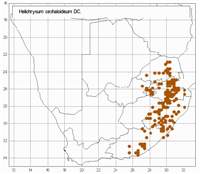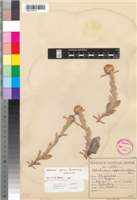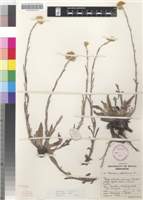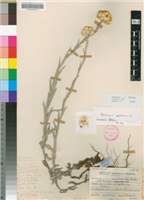Common names:
ibhade (Z)
Origin of name:
cephaloideum = head like
Diagnostic characters:
Large headsCompact inflorescenceLeaves woollyBracts yellow
Description:
Perennial herb, stock stout, woody, flowering stems several from the crown, simple or sometimes forked near base, erect to c. 400 mm, loosely grey-woolly, leafy throughout. Radical leaves rosetted, often withered at flowering, c. 20�50 x 10�20 mm, lanceolate-oblong or oblanceolate-oblong, apex acute, base broad, clasping, both surfaces loosely grey-woolly, upper also with coarse patent hairs, wool sometimes wanting; cauline leaves erect, imbricate, smaller than radical, decreasing in size upwards, oblong-lanceolate to lanceolate, acute to acuminate, uppermost tipped with a small scarious bract, base half-clasping, very shortly decurrent, both surfaces grey-woolly, upper sometimes glabrescent. Heads homogamous, campanulate, 4�5 (�6) mm long, several in a compact subglobose cluster up to c. 30 mm across, often webbed together at the base with wool. Involucral bracts in c. 6 series, subequal, loosely imbricate, exceeding flowers, radiating, glossy, bright yellow or deep straw-colour, outer often overlaid or tipped golden-brown or rarely purple-brown, outer acute, inner obtuse, apiculate. Receptacle with fimbrils exceeding ovaries. Flowers 30�70 (�103). Achenes 0.75 mm, barrel-shaped, glabrous. Pappus bristles many, equaling corolla, scabrid, tips barbellate, bases cohering by patent cilia.
Flowering between November and May, but principally from December to March.
Distribution:
Common in grassland. Ranges from the E. highlands of Zimbabwe to the high parts of the Limpopo and Gauteng (Soutpansberg, E. highlands, Highveld, Magaliesberg), western Swaziland, KwaZulu-Natal, NE. Free State, Lesotho, E. Cape as far west as the Amatola Mountains and Great Winterberg, and the Suurberg near Port Elizabeth.
Savanna, Grassland and Thicket Biomes.
Notes:
Typical H. cephaloideum from the E. Cape is characterized by its congested compound heads, the individual heads 4�5.5 mm long with subequal involucral bracts, the outer acute, the inner very obtuse and apiculate, and containing c. 30�60 flowers. Similar plants occur over the rest of the range, but in KwaZulu-Natal and in the old Transvaal heads are often larger (5�6 mm long) and may contain up to 100 flowers. In both provinces the area of H. cephaloideum overlaps with that of its close ally H. mixtum, and in KwaZulu-Natal with H. auriceps as well, and it is possible that some crossing takes place. However, the species seems also to be inherently variable, particularly in leaf size and woolliness and in the colour and imbrication of the involucral bracts. The bracts are often bright yellow overlaid or tipped golden-brown. Plants from the North with tawny or straw-coloured, closely imbricate, bracts were described as H. polyphyllum and H. campaneum; apart from the colour of the bracts, they closely resemble H. cephaloideum var. polycephalum, described from Grahamstown. The type of H. infuscum is very young, but it is perhaps no more than a specimen of H. cephaloideum in which the bracts are heavily overlaid with chestnut or purplish brown; plants with similarly coloured bracts occur sporadically in both KwaZulu-Natal and Mpumalanga, often together with ordinary yellow-headed plants.
Specimens with remarkably large radical leaves (up to 200 x 40 mm) have been collected in the grassland adjoining Ngome and Nkandla forests in KwaZulu-Natal (Hilliard & Burtt 5945, E; K; NH; NU; and Hilliard 2652, NU) and are possibly a local race.
H. cephaloideum is part of a very closely allied group that includes H. subluteum and H. ingomense, both of which may have been derived from H. cephaloideum, as well as H. auriceps, H. longifolium and H. mixtum. Further study is desirable.
Taxonomy:
Literature:
Helichrysum cephaloideum DC., Prodr. 6: 197 (1838) p.p.; Harv. in F. C. 3: 242 (1865); Hilliard & Burtt in Notes R. bot. Gdn Edinb. 32: 345 (1973); Hilliard, Compositae in Natal 186 (1977).
Type:
Lectotype: Cape, Albany, Zwartehoogde, Zuurberg range, Ecklon 1887 (G-DC).
Synonym(s):
H. adscendens var. cephaloideum (DC.) Moeser in Bot. Jb. 44: 319 (1910). Gnaphalium ecklonianum Sch. Bip. in Bot. Ztg 3: 171 (1845). G. hoffmannii O. Kuntze, Rev. Gen. 3,2: 151 (1898).
H. cephaloideumvar. polycephalum DC., Prodr. 6: 197 (1838). Type: Albany, Zwartehoogde, Zuurberg range, Ecklon 1862 (G-DC, holo.).
H. campaneum S. Moore in J. Bot., Lond. 41: 399 (1903). Type: Gauteng, Roodepoort, Rand 1301 (BM, holo.).
H. polyphyllum Conrath in Kew Bull. 1908: 225 (1908). Type: Gauteng, Modderfontein, Conrath 444 (K, holo.).
H. adscendens sensu Moeser in Bot. Jb. 44: 319 (1910), non (Thunb.) Less.
H. infuscum Burtt Davy in Jl S. Afr. Bot. 1: 108 (1935). Type: Limpopo, Pietersburg distr., The Downs, Rogers 21959 (BOL and K, holo.; PRE, iso.).
Vouchers:
Devenish 1604 (E; K; NU); Flanagan 2278 (PRE; SAM); Hilliard & Burtt 7755 (E; K; MO; NU; S); Moss 6881 (J; NU); Story 3467 (PRE).



